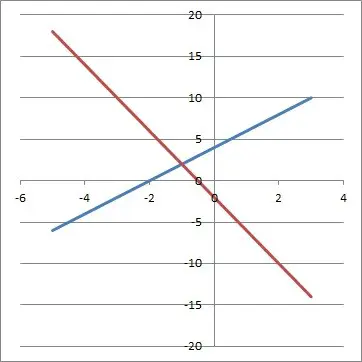What Is the Solution to the System of Equations Y=3x-2 and Y=g(X)
When working with systems of linear equations, we often see infinitely many solutions or 1 at all. Nonetheless, it is also possible that a linear system volition take exactly one solution.
So, when does a system of linear equations have ane solution? A system of two linear equations in 2 variables has one solution when the ii lines take dissimilar slopes. From an algebra standpoint, this means that we get a single value when solving the organisation. Visually, the lines intersect exactly once on a graph, since they have different slopes.
Of course, a system of three equations in iii variables has one solution if there is exactly one signal where all three planes intersect.
In this commodity, nosotros'll talk near how y'all can tell that a arrangement of linear equations has ane solution. We'll too look at some examples of linear systems with one solution in 2 variables and in iii variables.
Let's begin.
Systems Of Linear Equations With One Solution
A system of linear equations tin have ane solution if there is a single signal that makes every equation in the organization true. This means that there is ane point that can satisfy all of the equations at the same time.
The image below summarizes the 3 possible cases for the solutions for a arrangement of two linear equations in two variables.

A system of equations in ii, 3, or more variables can have 1 solution. We'll start with linear equations in 2 variables with one solution.
When Does A Linear Organization Accept One Solution? (System Of Linear Equations In 2 Variables)
There are a few ways to tell when a linear arrangement in two variables has one solution:
- Solve the system – if y'all solve the system and get a single equation (such equally 10 = 2 and y = 5), then in that location is 1 solution.
- Look at the graph – if the two lines have different slopes (they intersect exactly once), then there is i solution to the arrangement.
- Look at the slope and y-intercept – solve both equations for y to get slope-intercept form, y = mx + b. If the ii equations have unlike slopes, and then the two lines are dissimilar and are not parallel, so there is only one solution (you can get a refresher on how to tell when two lines are parallel in my commodity hither).
We'll wait at some examples of each case, starting with solving the system.
Solving A Linear System With One Solution
When we solve a linear system with one solution, we will become a result that gives us a single value for x and a single value for y. For example, after we solve, we will get something like ten = 2 and y = 5.
Allow's have a look at some examples to see how this tin happen.
Example one: Using Elimination To Show A Linear System Has Ane Solution
Allow'due south say we want to solve the following arrangement of linear equations:
- 2x + 4y = 3
- -6x – 8y = xi
We will utilize elimination to solve. Let's try to eliminate the "x" variable.
We begin by multiplying the beginning equation by three to get:
- 3(2x + 4y) = 3(3) [multiply the first equation past 3 on both sides]
- 6x + 12y = 9 [distribute the iii through parentheses]
At present we add this modified equation to the second i:
6x + 12y = ix
+
-6x – 8y = xi
___________
0x + 4y = 20
This implies y = 5. Substituting y = 5 into the first equation gives u.s.:
- 2x + 4y = 3
- 2x + iv(5) = 3
- 2x + 20 = 3
- 2x = -17
- x = -viii.5
So the solution is (-8.5, 5). We can examination this by substituting x = -8.five, y = 5 into both of the original equations to make certain nosotros go the right values.
Since there is only one ordered pair that makes both equations true, at that place is but 1 solution to this arrangement of linear equations. The graph below confirms that the lines have different slopes and intersect exactly one time.

Example ii: Using Exchange To Show A Linear System Has One Solution
Let's say nosotros want to solve the following system of linear equations:
- y = 2x + 5
- 3x + 4y = 9
We will use substitution to solve. Nosotros'll substitute the y from the first equation into the y in the second equation:
- 3x + 4y = 9 [offset with the 2nd equation]
- 3x + 4(2x + v) = nine [substitute y = 2x + 5 from the first equation]
- 3x + 8x + 20 = 9 [distribute 4 through parentheses]
- 11x = -eleven [combine like terms on opposite sides]
- x = -1 [divide by xi on both sides]
Now nosotros can substitute ten = -i into the first equation to get:
- y = 2(-i) + 5
- y = -2 + five
- y = 3
So the solution is (-1, three).
Since there is but one ordered pair that makes both equations truthful, at that place is only one solution to this organization of linear equations. The graph below confirms that the lines have dissimilar slopes and intersect exactly in one case.

Looking At The Graph Of A Linear Organization With Ane Solution
When we graph a linear system with one solution, we will get two unlike lines that are non parallel (that is, they will have dissimilar slopes).
Let'due south take a look at some examples to run into how this can happen.
Example 1: Graph Of 2 Intersecting Lines From A Linear Organization With One Solution
Allow's graph the following system of linear equations:
- y = 2x + 4
- y = -4x – 2
The lines have unlike slopes (2 and -4), as you can see in the graph below:

Since the slopes are dissimilar, the lines will intersect at exactly one signal. This means that there a single ordered pair (x, y) = (-1, ii) that is a solution to the linear system we started with (this is the just signal that lies on both lines).
Example 2: Graph Of Ii Intersecting Lines From A Linear System With One Solution
Allow's graph the following system of linear equations:
- 10 = two
- y = -three
The first line has an undefined slope (it is a vertical line), and the second line has a slope of zero. This tells u.s. that the slopes are different, as you can meet in the graph below:

Since the slopes are different, the lines will intersect at exactly ane point. This ways that in that location a single ordered pair (ten, y) = (2, -3) that is a solution to the linear system we started with (this is the merely point that lies on both lines).
Looking At The Slope & Y-Intercept To Show There Is One Solution To A Organisation Of Two Linear Equations
When we solve a linear equation for y, we go gradient-intercept form. If we practise this for both equations in a linear organization, we tin can compare the slope and y-intercept.
If the two slopes are different, so we take two different lines that are non parallel, significant they intersect at ane point and there is exactly i solution to the linear system.
Let's accept a wait at some examples to see how this can happen.
Example 1: Comparison Gradient & Y-Intercept To Show In that location Is One Solution To A Arrangement Of Two Linear Equations
Permit's say nosotros have the following organization of linear equations:
- 4x = – 2y + 8
- 3y = -12x + 6
We will solve for y in both equations to go slope-intercept form, y = mx + b.
Solving the offset equation for y, nosotros get:
- 4x = – 2y + 8
- 4x + 2y = 8 [add 2y to both sides]
- 2y = -4x + 8 [decrease 4x from both sides]
- y = -2x + 4 [divide by 2 on both sides]
Solving the second equation for y, we get:
- 3y = -12x + 6
- y = -4x + 2 [divide by 3 on both sides]
And then, the two equations in slope-intercept form are:
- y = -2x + iv
- y = -4x + 2
Since these two equations have different slopes (-2 and -iv), we know that they are two different lines that are not parallel. Since the lines intersect exactly in one case, there is one solution to the organisation: the point (-1, half dozen) which lies on both lines.

Example 2: Comparing Slope & Y-Intercept To Show In that location Is 1 Solution To A Arrangement Of 2 Linear Equations
Let's say we have the following system of linear equations:
- 30x = 6y – xviii
- 4y – 32x + 5 = xiii
We will solve for y in both equations to get gradient-intercept form, y = mx + b.
Solving the first equation for y, we go:
- 30x = 6y – eighteen
- 30x + 18 = 6y [add 18 to both sides]
- 5x + 3 = y [dissever past vi on both sides]
Solving the second equation for y, nosotros get:
- 4y – 32x + five = 13
- 4y – 32x = 13 – 5[subtract 5 from both sides]
- 4y – 32x = 8[combine like terms: constants]
- 4y = 32x + 8 [add 32x to both sides]
- y = 8x + 2 [split by 4 on both sides]
So, the 2 equations in slope-intercept form are:
- y = 5x + 3
- y = 8x + 2
Since these two equations have unlike slopes (5 and 8), we know that they are two dissimilar lines that are not parallel. Since the lines intersect exactly once, there is one solution to the system: the bespeak (1/three, 14/3) which lies on both lines.

How To Create A Organization Of Linear Equations With One Solution
To create a system of linear equations with one solution, we tin take a couple of approaches:
- One method is to start by choosing values "a" and "b" for whatsoever expression ax + by. Next, choose values of 10 and y for a solution (x, y). Then, summate the value of ax + by, which is the value of c. The equation ax + by = c is our showtime equation. Repeat the steps for some other pair of values "e" and "f", the aforementioned solution (x, y), and discover a value of "yard" to get the 2d equation ex + fy = k.
- Another method is to graph the solution (ten, y) and and then draw ii lines with dissimilar slopes that go through (x, y). Find the equation of both lines and yous volition have a organisation with a solution of (x, y).
Let'due south try each method in plough.
Example one: Create A Arrangement Of Linear Equations With One Solution
Permit's choose values of a = 2 and b = three. Then our equation will look like:
- ax + by = c
- 2x + 3y = c
All we demand to do is observe c for a given point (x, y). Let'due south choose ten = 1, y = iv to get:
- 2x + 3y = c
- 2(1) + 3(4) = c
- 2 + 12 = c
- 14 = c
So our first equation is
- 2x + 3y = 14 (a = 2, b = iii, c = 14)
Now we repeat the steps for our second equation.
Allow's choose values of e = 5 and f = 4. And then our equation volition look like:
- ex + fy = g
- 5x + 4y = one thousand
All we demand to exercise is observe thousand for the aforementioned point x = 1, y = 4:
- 5x + 4y = thousand
- 5(1) + 4(4) = g
- five + 16 = chiliad
- 21 = g
And so our second equation is
- 5x + 4y = 21 (due east = v, f = iv, g = 21)
Then the system of linear equations is:
- 2x + 3y = 14
- 5x + 4y = 21
We tin solve by commutation or elimination to verify that the solution is the point (1, 4).

Instance 2: Create A System Of Linear Equations With One Solution
Let'due south say we want a linear arrangement with a solution of (3, 7). We will draw 2 lines that go through this bespeak:
[graph of 2 lines below, and point (3, 7)]
The first line has a slope of 4 and a y-intercept of -5. Its equation is y = 4x – 5.
The second line has a slope of -2 and a y-intercept of 13. Its equation is y = -2x + thirteen.
So, our system of linear equation is:
- y = 4x – 5
- y = -2x + 13
We can solve by substitution or emptying to verify that the solution is the bespeak (three, seven).

Arrangement Of Linear Equations In Iii Variables With One Solution
A arrangement of equations in iii variables will have i solution if there is a single indicate where the 3 planes all intersect. Here is an example:
- x + y + z = ane
- 10 + y + 2z = 2
- x + 2y + 3z = 3
We can easily eliminate the variable x past subtracting equations:
- y + 2z = 2 [subtract first equation from third]
- z = 1 [subtract first equation from second]
Using z = 1 in the equation y + 2z = 2 gives u.s.a. y = 0.
Using z = 1 and y = 0 in the first equation gives usa x = 0.
So, the solution is the ordered triple (0, 0, i).
When Does A System Of Linear Equations Take A Solution?
A system of linear equations in two variables has a solution when the two lines intersect in at to the lowest degree one place.
- If the two lines have the same slope and the aforementioned y-intercept, then the 2 equations are equivalent, and they represent the same line (so there are infinitely many solutions, since every point on the line is a solution).
- If the 2 lines have different slopes, then they intersect at exactly ane point.
When Does A System Of Linear Equations Accept No Solution?
A organization of two linear equations in ii variables has no solution when the two lines are parallel.
From an algebra standpoint, this means that we get a false equation when solving the system.
Visually, the lines never intersect on a graph, since they have the same gradient only dissimilar y-intercepts.
Yous can learn more about this case (and some examples) in my article hither.
Conclusion
Now you know when a organization of linear equations has one solution. Y'all besides know what to look out for in terms of the slope, y-intercept, and graph of lines in these systems.
You might likewise observe it helpful to read my commodity on systems of linear equations with space solutions.
You can learn more nigh slope in this article.
I hope you constitute this article helpful. If then, please share it with someone who can use the information.
Don't forget to subscribe to my YouTube channel & get updates on new math videos!
~Jonathon
Source: https://jdmeducational.com/systems-of-linear-equations-with-one-solution-3-ways-to-tell/
0 Response to "What Is the Solution to the System of Equations Y=3x-2 and Y=g(X)"
Postar um comentário